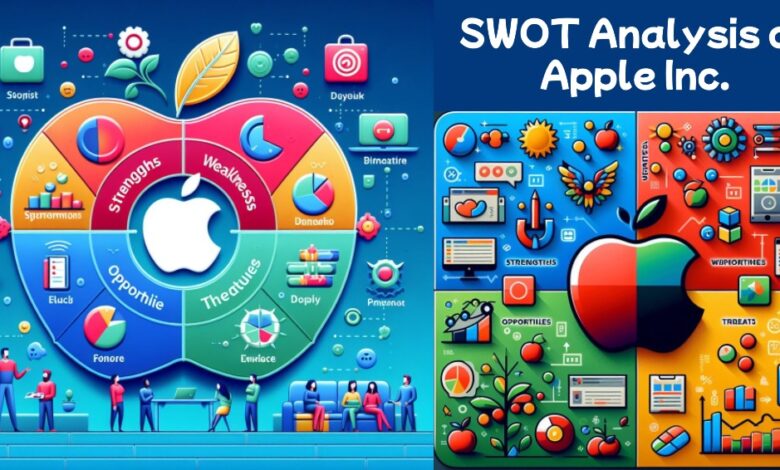A SWOT Analysis of Apple Inc.

The SWOT analysis of Apple reveals the company’s formidable strengths, strategic weaknesses, promising opportunities, and potential threats in the ever-evolving tech landscape.
Apple Inc., a name we all recognize, is a tech giant known for its innovative gadgets and software. From the iconic iPhone to the user-friendly iPad, Apple has made a significant impact in our lives. But, like any other company, Apple has its strengths and weaknesses, as well as opportunities and threats in the market. That’s where a SWOT analysis comes in handy. It helps us understand these aspects in a structured way. So, let’s dive into the world of Apple through the lens of a SWOT analysis.
SWOT Analysis of Apple
Strengths
Apple’s strengths lie in several key areas. First and foremost, Apple has strong brand recognition and a loyal customer base. This means that people around the world recognize Apple and trust its products, leading to repeat purchases and strong sales.
Secondly, Apple is known for its innovative products and services. From the first iPhone to the latest models, Apple has consistently pushed the boundaries of what’s possible in technology. This innovation has not only set Apple apart from its competitors but also created a strong demand for its products.
Thirdly, Apple’s products are known for their high quality and unique features. Whether it’s the sleek design of the MacBook or the user-friendly interface of iOS, Apple’s commitment to quality is evident in every product it releases.
Lastly, Apple has a leading edge in technology. With its operating systems, hardware designs, and proprietary applications, Apple has maintained control over its technology, allowing it to stay ahead of its competitors.
Weaknesses
Despite its many strengths, Apple also has some weaknesses that it needs to address. One of the most notable is the high price of its products. While the quality and innovation of Apple’s products often justify their cost, the high price tag can be a barrier for many potential customers, especially in emerging markets.
Another weakness is Apple’s limited advertising and promotions. Unlike other tech companies that invest heavily in marketing, Apple relies more on its brand image and word-of-mouth. While this strategy has worked well so far, it could limit Apple’s ability to reach new customers.
Apple’s decision to venture into areas of non-competency is also seen as a weakness. While diversification can be a good strategy, it can also lead to a lack of focus and dilution of the brand.
Finally, Apple’s products are often incompatible with other software. This means that users who want to use non-Apple products or services may find it difficult or impossible to do so on their Apple devices.
Opportunities
Apple has several opportunities that it can capitalize on. One of these is the consistent growth of its customer base. Despite the high price of its products, Apple continues to attract new customers, indicating a strong demand for its offerings.
Another opportunity lies in the pool of qualified professionals that Apple has. With a team of highly skilled and innovative individuals, Apple has the potential to continue leading the tech industry with groundbreaking products and services.
Apple’s expansive distribution network is also an opportunity. With stores and authorized sellers around the globe, Apple can reach customers in almost every corner of the world.
The lack of green technology in Apple’s products presents an opportunity for the company to incorporate more environmentally friendly technologies into its products, which could appeal to a growing segment of consumers who prioritize sustainability.
Lastly, Apple has the opportunity to expand its services. With the success of services like Apple Music and iCloud, Apple could further diversify its revenue streams by introducing new services.
Threats
Apple, like any other company, faces several threats in the market. One of the major threats is the after-effects of the Coronavirus outbreak. The pandemic has disrupted supply chains and affected consumer purchasing power, which could impact Apple’s sales and operations.
Another threat is the lack of an effective countermeasure for Air Tags. Competitors are developing similar products, and without a unique selling proposition, Apple’s Air Tags could lose market share.
Counterfeits are another significant threat to Apple. The market is flooded with fake Apple products, which not only affect Apple’s sales but also damage its brand image.
Lastly, Apple faces increasing competition in the tech industry. With companies like Samsung, Google, and Huawei continuously innovating and releasing new products, Apple needs to stay ahead of the curve to maintain its market position.
Conclusion
Apple Inc. is a formidable player in the tech industry, with a strong brand, innovative products, and a loyal customer base. However, it also faces challenges such as high product prices, limited advertising, and compatibility issues. Despite these challenges, Apple has numerous opportunities for growth and improvement, including expanding its customer base, leveraging its skilled workforce, and introducing more sustainable technologies. However, threats such as the impact of the pandemic, competition, and counterfeits cannot be ignored.
Based on this SWOT analysis, it’s clear that Apple needs to continue innovating, address its weaknesses, capitalize on its opportunities, and prepare for its threats. By doing so, Apple can ensure its continued success in the ever-evolving tech industry.







